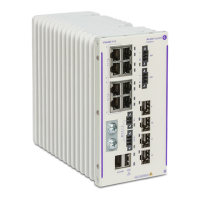Configuring IP Multicast Switching Modifying IPMSv6 Parameters
OmniSwitch AOS Release 8 Network Configuration Guide December 2017 page 25-39
You can also modify the MLD robustness variable from 1 to 7 on the specified VLAN or SPB service by
entering:
-> ipv6 multicast vlan 2 robustness 3
-> ipv6 multicast service 10 robustness 3
Restoring the MLD Robustness Variable
You can restore the MLD robustness variable to its default value on the system if no VLAN or SPB
service is specified by entering ipv6 multicast robustness followed by the value 0, as shown below:
-> ipv6 multicast robustness 0
Or, as an alternative, enter the following command to restore the MLD robustness to its default value:
-> no ipv6 multicast robustness
You can also modify the MLD robustness variable from 1 to 7 on the specified VLAN or SPB service by
entering:
-> ipv6 multicast vlan 2 robustness 0
-> ipv6 multicast service 10 robustness 0
Or, as an alternative, enter the following commands to restore the MLD robustness to its default value:
-> no ipv6 multicast vlan 2 robustness
-> no ipv6 multicast service 10 robustness
Enabling and Disabling MLD Spoofing
By default, MLD spoofing (i.e., replacing a client's MAC and IPv6 address with the system's MAC and
IPv6 address, when proxying aggregated MLD group membership information) is disabled on the switch.
The following subsections describe how to enable and disable spoofing by using the ipv6 multicast
spoofing command.
Enabling MLD Spoofing
To enable MLD spoofing on the system if no VLAN or SPB service is specified, you use the ipv6
multicast spoofing command as shown below:
-> ipv6 multicast spoofing enable
You can also enable MLD spoofing on the specified VLAN or SPB service by entering:
-> ipv6 multicast vlan 2 spoofing enable
-> ipv6 multicast service 10 spoofing enable
Specifying a Static Source IPv6 Address
By default, a source IPv6 address is not specified when MLD spoofing is enabled; the system
automatically determines the addresses to use for spoofing. However, a static source IPv6 address can be
specified to overcome the need for an IPv6 interface. If configured, the static source IPv6 address is then
always used for spoofing, regardless of the IPv6 interface address or administrative state.
To configure a static source IPv6 address for the system, use the ipv6 multicast spoofing command with
the static-source-ip parameter. For example:
-> ipv6 multicast spoofing static-source-ip 3333::1

